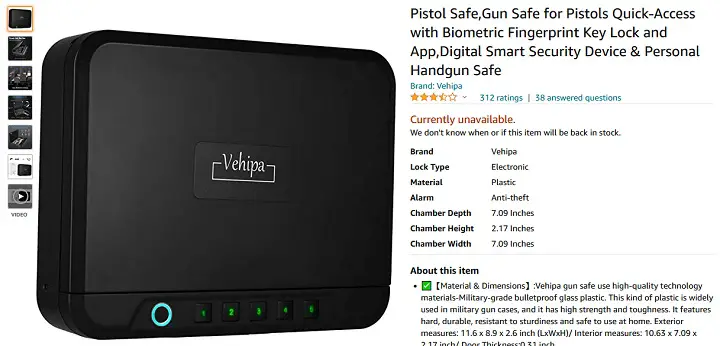 First of all, did he buy the safe at Home Depot? If so, the safe is probably worthless. Not worthless as in it can’t be resold to some other dummy hoping to protect some trinkets from snooping children or house guests. Just worthless as in it won’t keep determined individuals out for very long should they come wielding crowbars and blowtorches to get inside it.
First of all, did he buy the safe at Home Depot? If so, the safe is probably worthless. Not worthless as in it can’t be resold to some other dummy hoping to protect some trinkets from snooping children or house guests. Just worthless as in it won’t keep determined individuals out for very long should they come wielding crowbars and blowtorches to get inside it.
Determined individuals...such as you.
Or maybe you just want to know which types of safes to avoid when shopping for protection for your own treasure hoard.
In any case, we know you’re unlikely to believe much of anything just coming from us, so we've brought in some experts to discuss the matter. The friendly folks at Brown Safe have been constructing some of the highest quality, nearly impenetrable safes on the market for decades now. They gave us the sad truth about the current state of the safe business.
Here are 8 things you should know about safe cracking.
Like we said, the safe is probably worthless
“The startling truth is 95% of the safes built today are only designed to withstand attacks by common household tools for a maximum of 5 minutes. Even most high end safes fare only marginally better.” That’s a quote from Lynel Brown, VP of Brown Safe.
She has some experience in the field, having once cracked a safe purchased from a local department store in less than two minutes during a demonstration.
She adds that, “Hidden within the ranks of everyday immoral criminals, exists a highly capable class of criminal safecrackers, professional and highly efficient thieves capable of violating and emptying a fortified safe within minutes.
However, this is not the kind of criminal who will likely invade your home. The vast majority of safe attacks are performed by ill equipped idiots armed with simple crowbars and hammers…but in the vast majority of cases, these idiots will succeed.”
Blame China
A closely guarded secret within the safe industry…back in the 80’s an onslaught of extremely cheaply built foreign safes devastated the US safe manufacturing industry, crippling and destroying the reputable safe builders.
Facing extinction, most safe builders survived by severely cheapening the build quality of their own safes in order to directly compete with the Chinese knock-offs. Many builders gave up safe manufacturing altogether and served under the overseas aggressors as glorified distributors.
Only a handful of safe companies that produced quality safes managed to survive the slaughter.

The internet made it even worse
For years, the little known fact that safes were no longer impregnable strongboxes was concealed. The prior reputation safes carried was generally enough to prevent simple criminals from even attempting entry, and instead thieves searched elsewhere for easier pickings. However, with the advent of the internet and popular social networking sites like YouTube, the truth about safes spread like wildfire among the criminal element.
Type the word “safecracking” into any search engine today and you’ll be greeted with a vast library of friendly and easy to follow videos providing all manner of instructions on illicit safe entry.
The bottom line is most safes built today are now stupidly easy to crack, and even the most base criminals now know this. Thieves now immediately seek out safes in homes, as a safe provides an easy opening container of high value items that can be accessed within minutes.
What's typically in a safe, any way?
- Birth and marriage certificates
- Cash
- Guns
- Jewelry
- Important invoices
- Backup drives
- Life insurance policies
- Spare car or vehicle keys
- Passport
- Passwords
- Will/testament
- Social security card
- Deeds/title papers for homes, cars
- Powers of attorney
- Inventory of valuables/contents of home
- Sensitive or sentimental items he doesn't want you to find out about
Tools of the trade
So, let's get to work.
The crowbar
(Go to 2:40)
The doors of most safes are comprised of thin sheet metal wrapped around drywall to give the appearance of a thick door, in truth these doors are about as tough to open as a locked filing cabinet.
The most popular form of entry into these under built boxes is to simply wedge the tip of one or two pry-bars into the doors seam, then applying leverage. The thin walled steel rapidly buckles and gives way allowing the door to be pried up with ample time to spare.
The angle grinder
Fairly self-explanatory.
The hammer and wedge
A simple iron wedge placed and driven by a large hammer into at a few key locations along the safe’s door seam will rapidly push the locking bolts through the doors thin carriage walls, allowing for a fast entry.
The sledge
A favorite amongst the hooligans due to the severe damage inflicted on the safe, the perpetrator simply bashes through front of the safe door with the raw force of a sledge hammer…repeatedly. The flimsy safe door generally caves after only a few decent whacks and can then be pried back out with an enthusiastic yank.
Pretty unsettling info for safe owners. So what should you look for when you’re hoping to keep your mountains of gold bars safe?
Check the weight
Weight is the number one factor in determining a safe’s ability to protect from both fire and theft.
The best fire protection comes from cladding the safe in a dense layer of solid poured composite amalgamate material, which is roughly the same weight as high-density concrete. Fireboard, on the other hand, is a relatively light material. An inferior fireboard safe is easily identified by simply noting the safe’s low weight.
Protective steel plating is by far the heaviest and most expensive component of a quality safe, accounting for at least half of the safe’s overall weight. The thicker the steel, the heavier the safe.
The best safes for both fire and burglary are easy to spot as they weigh many times more than thin steel fireboard safes. These heavyweights are infinitely more capable safes, comparing their capabilities to the lighter models is like comparing an indy car to a go-kart.
Most safes provide some form of fire protection with little to no burglary protection. Few safes provide both forms of protection.
Look for steel
This highly significant category is simple to interpret: the higher the number, the more core burglary protection the safe will provide.
If you care about burglary protection, as 95% of buyers do, do not consider a safe with anything less than a half inch (0.50″) solid door steel, and quarter inch (0.25″) walls.
Bear in mind, all fire safes have thick robust looking doors, but only a small fraction of that door is actual steel. Most of the door, especially on less expensive safes, is comprised of fireboard wrapped in ultra thin sheet metal.
If a safe is heavy, it doesn’t necessarily mean it has a lot of steel. There’s a good chance this weight comes from the composite material which is far less expensive on the builders budget. Bottom line, always find out how much real solid steel plating a safe has prior to purchase.
***
Much thanks go out to Lynel Brown and everyone at Brown Safe for their help with this article. To pick up your very own Brown Safe, including military-grade badassery like a safe completely encased in the same ballistic armor used by military vehicles and fortified installations to withstand severe attack by extensive gunfire, grenades, and missiles, start here.
 |
 Ape Out Shirt $21.68 |
 |

You can point a hidden nanny cam at the safe and have an app that alerts you whenever there's movement. That's what I would do.